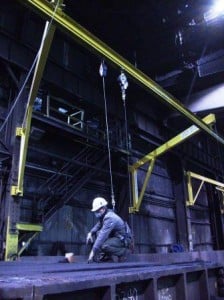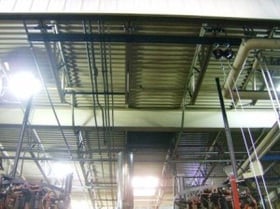Potential clients contacting DFP via phone or e-mail often have pre-conceived notions about the type of fall protection system best suited for their specific application. In many instances, what folks think they want and what they actually need represent very different approaches to fall protection.  An e-mail message received earlier this week is a perfect illustration:
An e-mail message received earlier this week is a perfect illustration:
Message: I work in a plastic injection shop. Our machines are as high as 20 feet. We are looking for fall protection to protect employees when they clamp in molds. Can my employees stand and work at greater heights than the tie-off area they connect lanyards to?
Response: This is a very good question and we are glad you asked because there are certain fall distances that are taken into account in various situations. If you are attaching at your feet you will need a shock absorbing lanyard– typically a 6ft length one. To give you a tally of how far the worker will fall if attached at the same height as their feet: 6ft lanyard + 5ft person length to D-ring + 3.5ft pullout from lanyard + 1ft harness take-up = 15.5ft total fall distance from attachment point/working platform. This worker is going take a significant fall that leaves them just a few feet from the ground. You also need to consider a rescue plan and make sure you can reach workers in the event of a fall.
If you need to limit the distance the worker falls in order to make for a smoother rescue plan, you might want to explore the option of an overhead fall protection fixed rigid rail or a fold away jib type system. This type of system will also decrease the total fall distance for your worker. I am enclosing some pictures of our work in the plastics and rubber industry to show how these systems work.
 Identifying workplace fall hazards and partnering with a certified company that understands fall protection is an important steps towards becoming OSHA compliant. Our years of design, fabrication, and installation of fall protection systems will keep your company compliant…and your employees safe. To learn more about fall protection systems for the rubber and plastics industries, or to request a quote, contact DFP for more information.
Identifying workplace fall hazards and partnering with a certified company that understands fall protection is an important steps towards becoming OSHA compliant. Our years of design, fabrication, and installation of fall protection systems will keep your company compliant…and your employees safe. To learn more about fall protection systems for the rubber and plastics industries, or to request a quote, contact DFP for more information.

